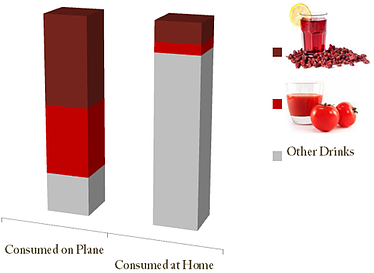All seasoned business travelers have their share of funny or painful airline stories, and I’m no exception. But a particularly memorable incident on a recent flight to SFO got me thinking, and it’s the genesis for this blog.
Long story short, I was sitting by the window and celebrating the open middle seat next to me when a 6’8” 350 lb. man shuffled down the aisle and plopped into it. Our conversation went exactly like this:Giant: “I know, I know, I’m a giant. Sorry.”
Brant: “I have to admit, I was chanting ‘not him, not him’ from the moment you walked on. Sorry.”
From there the conversation (between my snores) was amiable. And then, somewhere over the Great Plains, my new friend spilled cranberry juice all over his seat-back table, and himself. Have you ever seen a man that size try to clean himself in an area that small? Not pretty.
My mind ran with this incident, and I immediately started thinking about the seemingly ridiculous (to me anyway) amount of cranberry and tomato juice that is consumed on airplanes. The data below is completely fictitious, but I bet it is directionally accurate.

Now, what does this have to do with market research? Not much… but I’ll reach.
To me, the chart above segues nicely into a discussion of the differences between Market Segmentation, and Needs-State (AKA “Occasion-Based”) Segmentation.
Market Segmentation groups people or businesses into mutually exclusive and collectively exhaustive (MECE) groups. It is limited by the realities that people and businesses are complex, don’t always think or behave the same way all the time, and because of this any segmentation scheme is forced to be an over-simplification of reality. However, despite these limitations, great market segmentation can provide businesses with a common lexicon to use to describe the audiences it serves, prioritization of who to invest in, and the foundation for understanding what to say and where to say it in marketing at a brand level. Market Segmentation is great for setting strategy. If I’m a cranberry juice company, I’m going to go after segments that drink a lot of juice (kids, active women in their 40s, health/energy motivated people, etc.) But it is far less useful in some important areas … namely in identifying the best places to reach our core segments, what improvements to make, and how to grow our business beyond the core. This is where Needs-State Segmentation comes into play.
Needs-State Segmentation groups together occasions (e.g., shopping trip types, travel trip types, usage occasions and information gathering moments) based on common needs, rather than grouping people or businesses. While the Needs-States are mutually exclusive, each person/business can experience multiple needs states as they interact with the category. Needs-State Segmentation has two major orientations: purchase decision occasions, and usage occasions. A segmentation focused on purchase decision occasions will break down all of the critical moments in the purchase funnel where the process of buying is impacted (from seeing a commercial on T.V. to chatting with a friend / WOM). This type of segmentation will dramatically improve a company’s ROI on their integrated marketing plans by highlighting the most important occasions to hit and what to communicate in them. In contrast, a segmentation focused on usage occasions will lay out all of the moments when actual product usage occurs and what distinct needs must be fulfilled in each. This is the bread and butter of innovation for both short-term improvements within an existing line of products and for longer-term high growth innovation where a new niche in the market is identified (like when Red Bull figured out that it could target the mid-night clubbing need state rather than the afternoon-pick-me-up occasion).
Market Segmentation and Needs-State Segmentation complement each other. I can only assume that cross-country flights are a unique need state, where multiple segments swerve from their typical behaviors and begin pining for bright red liquids. The question here is do the bright red liquid companies know this? And if they do, do they understand the need state deeply enough to take full advantage of it?
Posted by Brant Cruz and Lori Wahl, Brant is resident segmentation guru and the Vice President of CMB’s eCommerce and Retail Practice. Read more of Brant’s thoughts on segmentation here.
Lori is a former CPG marketer turned researcher, who now runs her own strategic qualitative research consultancy, BIGinsightz. Lori is an expert in strategic market research, having built three best-in-class insight processes for her former company that drive product, branding and selling strategies. You can reach her at BIGinsightz@gmail.com

